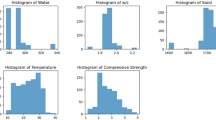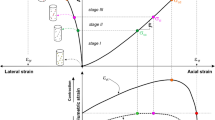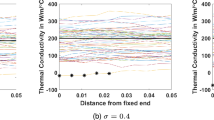Abstract
Accurate viscosity of molten blast furnace (BF) slag is indispensable for the development of centrifugal-granulation-assisted thermal energy recovery (CGATER) to decarbonize the iron and steel industry. Yet, direct experimental measurement of this quantity remains a formidable task due to the high temperature of 1600 Kelvin or above. Empirical models, if with high fidelity, are ideal to enable a fast and accurate prediction of the high-temperature viscosity of molten blast furnace slag. In this communication, we embark on a new effort to develop an artificial neural network (ANN)-based model to provide accurate viscosity prediction of molten blast furnace slag. This model was established based on a grid search method with approximately 4000 experimental measurements collected as the train and validation datasets. The viscosities of three types of molten blast furnace slag were measured above 1600 K as cross validation for the ANN model. Our ANN model agrees well with the experimental measurement with a small uncertainty of < 6%. Finally, an open-source artificial neural network code with a graphical user interface (GUI) was developed to provide a user-friendly portal for high-fidelity viscosity prediction. The present study not only enables a definitive, unified viscosity determination but also provides a flexible tool for the database establishment of the thermophysical properties of molten BF slag.
Graphical Abstract

We developed an ANN-based model to enable fast and accurate viscosity prediction of molten blast furnace slags at high temperatures and provided a user-interfaced open-source program, i.e. X-slag: Thermophysical Property.








Similar content being viewed by others
References
Zhang H, Wang H, Zhu X et al (2013) A review of waste heat recovery technologies towards molten slag in steel industry. Appl Energy 112:956–966
https://worldsteel.org/steel-by-topic/statistics/world-steel-in-figures/
Lv Yiwen, Zhu Xun, Wang Hong, et al (2020) Centrifugal granulation and waste heat recovery technology for high temperature molten slag. China Basic Sci 28–36
Ding B, Zhu X, Wang H et al (2018) Numerical investigation on phase change cooling and crystallization of a molten blast furnace slag droplet. Int J Heat Mass Transf 118:471–479
Gao J, Feng Y, Feng D et al (2020) Solidification with crystallization behavior of molten blast furnace slag particle during the cooling process. Int J Heat Mass Transf 146:118888
Lv Y-W, Zhu X, Wang H et al (2021) A hybrid cooling system to enable adhesion-free heat recovery from centrifugal granulated slag particles. Appl Energy 303:117645
Liu J, Yu Q, Peng J et al (2015) Thermal energy recovery from high-temperature blast furnace slag particles. Int Commun Heat Mass Transfer 69:23–28
Zhao YY (2004) Analysis of flow development in centrifugal atomization: Part I. Film thickness of a fully spreading melt. Modell Simul Mater Sci Eng 12:959–971
Wang D, Ling X, Peng H (2014) Theoretical analysis of free-surface film flow on the rotary granulating disk in waste heat recovery process of molten slag. Appl Therm Eng 63:387–395
Pan Y, Witt PJ, Kuan B, Xie D (2014) CFD modelling of the effects of operating parameters on the spreading of liquids on a spinning disc. J Comput Multiphase Flows 6:49–64
Kato M, Minowa S (1969) Viscosity measurements of molten slag. Trans ISIJ 9:31–38
Machin JS, Hanna DL (1945) Viscosity studies of system CaO-MgO-Al2O3-SiO2: 1, 40% SiO2*. J Am Ceram Soc 28:310–316
Machin JS, Yee TB (1948) Viscosity studies of system CaO-MgO-Al2O3-SiO2: II, CaO-Al2O3-SiO2*. J Am Ceram Soc 31:200–204
Machin JS, Yee TB, Hanna DL (1952) Viscosity studies of system CaO–MgO–Al2O3–SiO2: III, 35, 45, and 50% SiO2. J Am Ceram Soc 35:322–325
Machin JS, Yee TB (1954) Viscosity studies of system CaO–MgO–Al2O3–SiO3: IV, 60 and 65% SiO2. J Am Ceram Soc 37:177–186
Onodera K, Nakamura A, Hakamada S, et al (2016) Thermophysical Property Measurements of Molten Slag and Welding Flux by Aerodynamic Levitator. In: Advances in Molten Slags, Fluxes, and Salts: Proceedings of The 10th International. p 8
Siafakas D, Matsushita T, Jarfors AEW et al (2018) Viscosity of SiO2–CaO–Al2O3 slag with low silica—influence of CaO/Al2O3, SiO2/Al2O3 ratio. ISIJ Int 58:2180–2185
Fang SJ, Pang Z, Xing X, Xu R (2021) Thermodynamic properties, viscosity, and structure of CaO–SiO2–MgO–Al2O3–TiO2–based slag. Materials 14:1–12
Feng C, Gao L, Tang J et al (2020) Effects of MgO/Al2O3 ratio on viscous behaviors and structures of MgO–Al2O3–TiO2–CaO–SiO2 slag systems with high TiO2 content and low CaO/SiO2 ratio. Trans Nonferrous Met Soc China 30:800–811
Yan B, Liu Y, Shu Q et al (2019) Measurements and model estimations of viscosities of the MnO-CaO-SiO2-MgO-Al2O3 melts. Metall Mater Trans B 50:376–384
Jiao KX, Chang ZY, Chen C, Zhang JL (2019) Thermodynamic properties and viscosities of CaO-SiO2-MgO-Al2O3 slags. Metall Mater Trans B 50:1012–1022
Chen Z, Wang H, Sun Y et al (2019) Insight into the relationship between viscosity and structure of CaO-SiO2-MgO-Al2O3 molten slags. Metall Mater Trans B 50:2930–2941
Urbain G (1987) Viscosity estimation of slags. Steel Res 58:111–116
Mills KC, Sridhar S (1999) Viscosities of ironmaking and steelmaking slags. Ironmak Steelmak 26:262–268
Iida T, Sakai H, Kita Y, Shigeno K (2000) An equation for accurate prediction of the viscosities of blast furnace type slags from chemical composition. ISIJ Int 40:S110–S114
Iida T, Sakai H, Kita Y, Murakami K (2000) Equation for estimating viscosities of industrial mold fluxes. High Temp Mater Process (London) 19:153–164
Ray HS, Pal S (2004) Simple method for theoretical estimation of viscosity of oxide melts using optical basicity. Ironmak Steelmak 31:125–130
Hu X, Ren Z, Zhang G et al (2012) A model for estimating the viscosity of blast furnace slags with optical basicity. Int J Miner Metall Mater 19:1088–1092
Han C, Chen M, Zhang W et al (2015) Viscosity model for iron blast furnace slags in SiO2-Al2O3-CaO-MgO system. Steel Res Int 86:678–685
Duan WJ, Yu QB, Liu JX et al (2016) Research on characteristics and modelling estimation of molten BF slag viscosity in the process of slag waste heat recovery. Ironmak Steelmak 43:730–738
Gan L, Lai C (2014) A general viscosity model for molten blast furnace slag. Metall Mater Trans B 45:875–888
Frenkel J (1946) Kinetic theory of liquids. Clarendon Press, Oxford
Weymann HD (1962) On the hole theory of viscosity, compressibility, and expansivity of liquids. Kolloid-Zeitschrift & Zeitschrift Polym 181:131–137
Vogel H (1921) Das temperaturabhängigkeitsgesetz der viskosität von flüssigkeiten. Phys Z 22:645–646
Fulcher GS (1925) Analysis of recent measurements of the viscosity of glasses. J Am Ceram Soc 8:339–355
Tammann G, Hesse W (1926) The dependence of viscosity upon the temperature of supercooled liquids. Z Anorg Allg Chem 156:245–257
Rijin C, Hongwei Ni, Xianwang Li et al (2012) Predicting viscosity of blast furnace slag based on BP neural network model: an experimental study. J Wuhan Univ Sci Technol 35:411–414
Jiang D, Zhang J, Wang Z et al (2020) A prediction model of blast furnace slag viscosity based on principal component analysis and K-nearest neighbor regression. JOM 72:3908–3916
Hanao M, Kawamoto M, Tanaka T, Nakamoto M (2006) Evaluation of viscosity of mold flux by using neural network computation. ISIJ Int 46:346–351
Tan Y, Wang H, Zhu X et al (2020) Film fragmentation mode: The most suitable way for centrifugal granulation of large flow rate molten blast slag towards high-efficiency waste heat recovery for industrialization. Appl Energy 276:115454
Neal RM (2007) Pattern recognition and machine learning. Technometrics 49:366–366
Haykin SS, Haykin SS (2009) Neural networks and learning machines, 3rd edn. Prentice Hall, New York
Karimi H, Yousefi F (2012) Application of artificial neural network–genetic algorithm (ANN–GA) to correlation of density in nanofluids. Fluid Phase Equilib 336:79–83
Hemmat Esfe M, Yan W-M, Afrand M et al (2016) Estimation of thermal conductivity of Al2O3/water (40%)–ethylene glycol (60%) by artificial neural network and correlation using experimental data. Int Commun Heat Mass Transfer 74:125–128
Ali A, Ilyas SU, Garg S et al (2020) Dynamic viscosity of Titania nanotubes dispersions in ethylene glycol/water-based nanofluids: experimental evaluation and predictions from empirical correlation and artificial neural network. Int Commun Heat Mass Transfer 118:104882
Paduszyński K, Domańska U (2014) Viscosity of ionic liquids: an extensive database and a new group contribution model based on a feed-forward artificial neural network. J Chem Inf Model 54:1311–1324
Valderrama JO, Muñoz JM, Rojas RE (2011) Viscosity of ionic liquids using the concept of mass connectivity and artificial neural networks. Korean J Chem Eng 28:1451–1457
Chen Z, Wang M, Wang H et al (2022) Designing structure–thermodynamics-informed artificial neural networks for surface tension prediction of multi-component molten slags. Metall Mater Trans B 53(4):2018–2029
Chen Z, Wang M, Meng Z et al (2021) Development of structure-informed artificial neural network for accurately modeling viscosity of multicomponent molten slags. Ceram Int 47:30691–30701
Kim H, Matsuura H, Tsukihashi F et al (2013) Effect of Al2O3 and CaO/SiO2 on the viscosity of calcium-silicate–based slags containing 10 mass pct MgO. Metall Mater Trans B 44:5–12
Fukuyama H, Hiroyuki Fukuyama YW (2009) High-temperature measurements of materials. Springer, Berlin
Brooks RF, Dinsdale AT, Quested PN (2005) The measurement of viscosity of alloys—a review of methods, data and models. Meas Sci Technol 16:354–362
Chen-guang BAI, Zhi-ming YAN, Zheng-de PANG et al (2020) Advances of measurement and calculation model of slag viscosity. Iron & Steel 55:27–37
Saito N, Hori N, Nakashima K, Mori K (2003) Viscosity of blast furnace type slags. Metall Mater Trans B 34:509–516
Shankar A, Görnerup M, Lahiri AK, Seetharaman S (2007) Experimental investigation of the viscosities in CaO-SiO2-MgO-Al2O3 and CaO-SiO2-MgO-Al2O3-TiO2 slags. Metall Mater Trans B 38:911–915
Dong X-J, Sun H-Y, She X-F et al (2014) Viscosity and viscosity estimation model of fully liquid slags in TiO2–Al2O3–CaO–SiO2 and TiO2-Al2O3–CaO–SiO2–MgO systems with high TiO2 concentration and low mass ratio of CaO to SiO2. Ironmak Steelmak 41:99–106
Tang X, Zhang Z, Guo M et al (2011) Viscosities behavior of CaO-SiO2-MgO-Al2O3 slag with low mass ratio of CaO to SiO2 and wide range of Al2O3 content. J Iron Steel Res Int 18:1–17
Zhen Y-L, Zhang G-H, Tang X-L, Chou K-C (2014) Influences of Al2O3/CaO and Na2O/CaO ratios on viscosities of CaO-Al2O3-SiO2-Na2O Melts. Metall and Mater Trans B 45:123–130
Liao JL, Li J, Wang XD, Zhang ZT (2012) Influence of TiO2 and basicity on viscosity of Ti bearing slag. Ironmak Steelmak 39:133–139
Kim JR, Lee YS, Min DJ et al (2004) Influence of MgO and Al2O3 contents on viscosity of blast furnace type slags containing FeO. ISIJ Int 44:1291–1297
Hurst HJ, Novak F, Patterson JH (1999) Viscosity measurements and empirical predictions for some model gasifier slags. Fuel 78:439–444
Urbain G, Bottinga Y, Richet P (1982) Viscosity of liquid silica, silicates and alumino-silicates. Geochim Cosmochim Acta 46:1061–1072
Ohno A, Ross HU (1963) Optimum slag composition for the blast-furnace smelting of titaniferous ores. Can Metall Q 2:259–279
Kozakevitch P (1960) Viscosité et éléments structuraux des aluminosilicates fondus : laitiers CaO-AI 2 O 3 -Sio 2 entre 1 600 et 2 100 °C. Rev Métall 57:149–160
Ma X, Chen M, Zhu J et al (2018) Properties of Low-MgO ironmaking blast furnace slags. ISIJ Int 58:1402–1405
Zhang S, Zhang X, Liu W et al (2014) Relationship between structure and viscosity of CaO-SiO2-Al2O3-MgO-TiO2 slag. J Non-Cryst Solids 402:214–222
Chen M, Zhang D, Kou M, Zhao B (2014) Viscosities of iron blast furnace slags. ISIJ Int 54:2025–2030
Park H, Park JY, Kim GH, Sohn I (2012) Effect of TiO2 on the viscosity and slag structure in blast furnace type slags. Steel Res Int 83:150–156
Sohn I, Wang W, Matsuura H et al (2012) Influence of TiO2 on the viscous behavior of calcium silicate melts containing 17 mass% Al2O3 and 10 mass% MgO. ISIJ Int 52:158–160
Song M, Shu Q, Sichen D (2011) Viscosities of the quaternary Al2O3-CaO-MgO-SiO2 slags. Steel Res Int 82:260–268
Kim H, Kim WH, Sohn I, Min DJ (2010) The effect of MgO on the viscosity of the CaO-SiO2-20wt%Al2O3-MgO slag system. Steel Res Int 81:261–264
Park JH, Kim H, Min DJ (2008) Novel approach to link between viscosity and structure of silicate melts via Darken’s excess stability function: focus on the amphoteric behavior of alumina. Metall Mater Trans B 39:150–153
Talapaneni T, Yedla N, Pal S, Sarkar S (2017) Experimental and theoretical studies on the viscosity-structure correlation for high alumina-silicate melts. Metall Mater Trans B 48:1450–1462
Yao L, Ren S, Liu G et al (2015) Study of the effect of the MgO/Al2O3 ratio on viscosity of blast furnace slag. Metall Res Technol 112:602
Pati A, Sahoo SK, Mishra B, Mohanty UK (2018) Viscosity of industrial blast furnace slag in Indian scenario. Trans Indian Inst Met 71:801–812
Chevrel MO, Giordano D, Potuzak M et al (2013) Physical properties of CaAl2Si2O8–CaMgSi2O6–FeO–Fe2O3 melts: analogues for extra-terrestrial basalt. Chem Geol 346:93–105
Lee YS, Min DJ, Jung SM, Yi SH (2004) Influence of basicity and FeO content on viscosity of blast furnace type slags containing FeO. ISIJ Int 44:1283–1290
Koshida T, Ogasawara T, Kishidaka H (1981) Viscosity, surface tension, and density of blast furnace slag and synthetic slags at manufacturing condition of hard granulated slag. Tetsu-to-Hagane 67:1491–1497
Kim WH, Sohn I, Min DJ (2010) A study on the viscous behaviour with K2O additions in the CaO-SiO2-Al2O3-MgO-K2O quinary slag system. Steel Res Int 81:735–741
Wu L, Gran J, Sichen D (2011) The effect of calcium fluoride on slag viscosity. Metall Mater Trans B 42:928–931
Qiu G, Chen L, Zhu J et al (2015) Effect of Cr2O3 addition on viscosity and structure of Ti-bearing blast furnace slag. ISIJ Int 55:1367–1376
Wang H, Chen Z, Liu L et al (2018) Roles of P2O5 addition on the viscosity and structure of CaO–SiO2–Al2O3–Na2O–P2O5 melts. ISIJ Int 58:1644–1649
Kekkonen M, Oghbasilasie H, Louhenkilpi S (2012) Viscosity models for molten slags
Willman J (2021) Modern PyQt: create GUI applications for project management, computer vision, and data analysis. Apress, Berkeley
Acknowledgements
This work is supported by the National Natural Science Foundation of China (52206070), Innovative Research Group Project of National Natural Science Foundation of China (52021004) and Venture & Innovation Support Program for Chongqing Overseas Returnees (cx2021080).
Author information
Authors and Affiliations
Corresponding authors
Ethics declarations
Conflict of interest
The authors declare that there are no conflicts of interest.
Additional information
The contributing editor for this article was Sharif Jahanshahi.
Publisher's Note
Springer Nature remains neutral with regard to jurisdictional claims in published maps and institutional affiliations.
Supplementary Information
Below is the link to the electronic supplementary material.
Rights and permissions
Springer Nature or its licensor (e.g. a society or other partner) holds exclusive rights to this article under a publishing agreement with the author(s) or other rightsholder(s); author self-archiving of the accepted manuscript version of this article is solely governed by the terms of such publishing agreement and applicable law.
About this article
Cite this article
Liu, Q., Wu, J., Shao, Y. et al. ANN-Based Model to Predict the Viscosity of Molten Blast Furnace Slag at High Temperatures of > 1600 K. J. Sustain. Metall. 9, 1020–1032 (2023). https://doi.org/10.1007/s40831-023-00706-0
Received:
Accepted:
Published:
Issue Date:
DOI: https://doi.org/10.1007/s40831-023-00706-0




